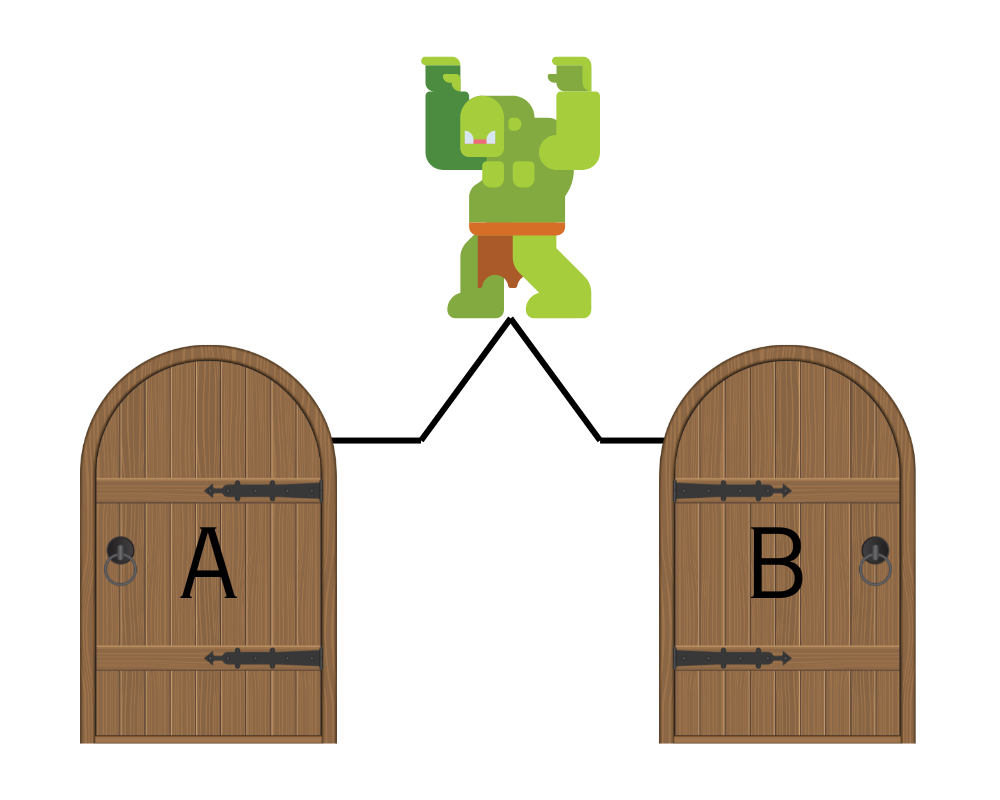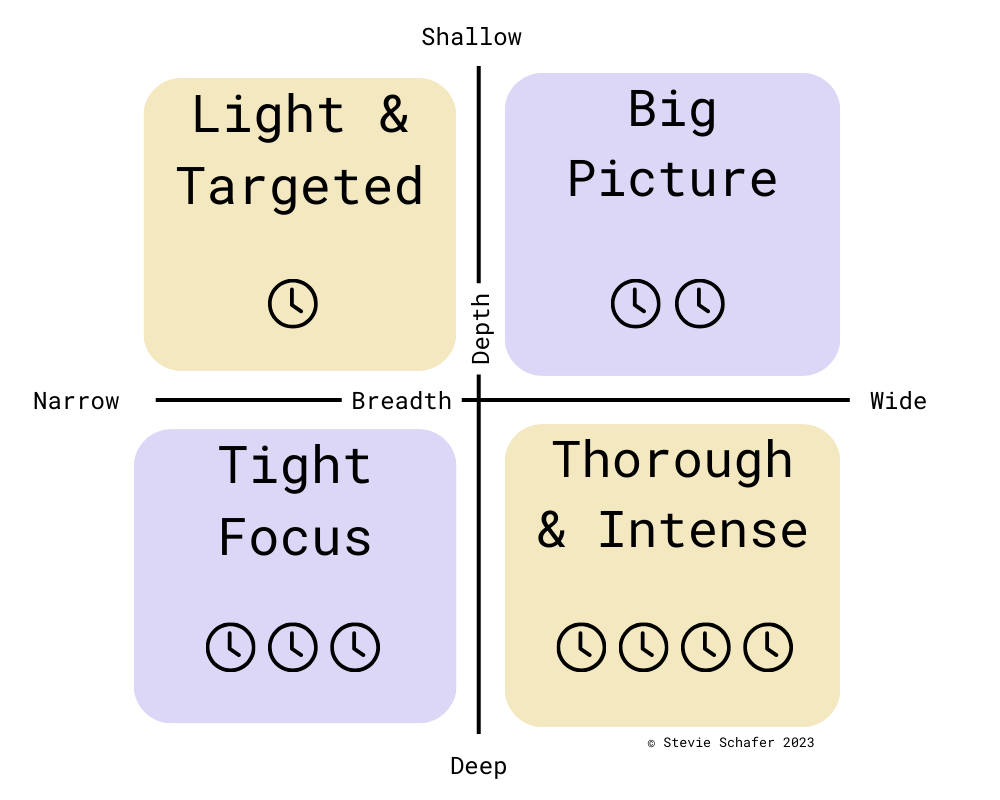Is the “Quantum Ogre” bad for TTRPGs?
One of the latest TTRPG debates going around on TikTok (I spend way too much time on that platform) is the Game Master tool known as the “Quantum Ogre”.
In this blog post, I’m going to discuss:
What is the Quantum Ogre?
“Shallow” vs “Deep” Quantum Ogres
The ethics of using Quantum Ogres
Why Quantum Ogres are common advice for new GMs
and my final thoughts.
Without further ado, let’s dive into the definition of what even is a “Quantum Ogre”.
What is the Quantum Ogre?
The ‘Quantum Ogre’ is usually presented something like this:
The players are faced with two different doors. They decide to go through door A.
Behind Door A is an Ogre.
But what if they went through Door B instead?
Also, an Ogre.
It simultaneously exists on both paths and neither path until the players choose. Like Schrödinger’s cat, it’s in a quantum state until observed.
This is an encounter-level example of a Quantum Ogre (or a “Shallow Ogre”, which I discuss further down). The Game Master has planned for an Ogre encounter and will put it in front of the player - no matter what path they go down.
This is the Quantum Ogre concept very simplified.
Caveat: If Something Works for your Table
Every GM and their pet Owlbear has an opinion on GMing styles. But ultimately, TTRPGs are games we play for FUN.
If something works for you and your game table, that’s what matters. If you and your table are having fun, who cares if you use the Quantum Ogre or not - certainly not me!
The Quantum Ogre is one potential tool in the Game Master toolkit.
I’m not going to tell you that you’re a bad Game Master for using Quantum Ogres. Nor am I going to tell you you’re terrible if you don’t use it. Your table is YOURS. Not mine.
Like GM PCs (a PC that the Game Master controls - as distinct from NPCs), I think tools are neutral - it comes down to how they are used.
Shallow Ogres Vs Deep Ogres
The example I gave earlier of Doors A and B is the most simplified version of the Quantum Ogre. And it’s shallow.
“Just come up with a different monster for Door B. It’s not that difficult,” detractors of the Quantum Ogre decry. And I get where they’re coming from. Because with that example, the amount of time it would take to just create a separate and distinct encounter is pretty insignificant.
Here’s where I think it’s important to make the distinction between Shallow Ogres and Deep Ogres. “Shallow” vs “Deep” is about how much detail has gone into the preparation.
Broadly speaking, Game Master preparation falls on two spectrums - depth and breadth. Depth is how much detail you dive into. Breadth is how zoomed out your lens is.
New Game Masters often come into the hobby with the misguided belief or aspiration that great GMs prepare DEEP and WIDE (bottom right quadrant of the Game Master preparation matrix). That is very rarely true.
Much of the GMing advice I’ve heard over the years actually pushes people up into the Shallow and Wide quadrant - the Big Picture.
And here you do get great bang-for-your-buck - especially if improvisation is totally your jam. You have the most amount of flexibility when responding to player choices. The detail gets filled in at the table.
However, I, like many Game Masters, find myself toggling between two modes of preparation - Big Picture and then fill in some of the detail with Tight Focus.
But what do I choose to focus on in the Tight Focus?
I make an educated guess about what the players are most likely to do. But this isn’t perfect. Players can and do make choices that I didn’t account for - or didn’t even see as possibilities.
When this happens, I’m left with two choices:
Discard whatever was prepped in the tight focus
Repurpose it (somewhere or somehow).
For example, let’s say I’ve built out a cult in Town A because I thought it likely that the players with their underground connections would discover this cult while in Town A for another purpose.
However, the players didn’t follow the clues to that subplot and focused on the main plot and left Town A, heading for Town B.
Planning out the cult was Deep Preparation. I have an Org Chart and everything!
I don’t think it’s controversial to say that throwing out Deep work feels wasteful. GMs don’t have infinite amounts of time to invest in preparing for games. And finding a way to reuse material that a not insignificant amount of time went into preparing feels bad.
In this example, shifting the cult from Town A to Town B is resourceful. It’s repurposing.
So where do people draw the line between repurposing (Deep Quantum Ogres) and cheap tricks (Shallow Quantum Ogres)? Why is one seen as smart, while the other is seen as cheating the players of decisions?
The Ethics of Using Quantum Ogres
One of the main criticisms I’ve seen against Quantum Ogres is that they rob your players of meaningful choices - especially the Shallow Ogres.
Here’s how that argument usually goes: If there’s an ogre no matter if they go behind door A or B, you’re lying to the players, you’re robbing them of any agency - of the ability to choose and choose meaningfully. “Why play TTRPGs if player choices don’t matter? You’d be better off putting that creative muscle to work writing a book!”
I think this complaint is an example of an oversimplification fallacy. Sure, when the Quantum Ogre is presented as two identical doors and it doesn’t matter which on the players go through, the outcome is the same - this is clearly pointless and arbitrary and is robbing the players of meaningful choices. Shallow Ogres can feel like cheating your players.
But is that actually what happens in practice? And how often do GMs who use the Quantum Ogre actually use it at the table?
If it’s 100% of the time, then yes, this criticism holds. But I don’t see that much in practice at the table.
It’s more of a mix of Quantum Ogres (shallow or deep) and genuine response to player action.
Like all GM advice, if you find using Quantum Ogres to be deplorable, no one is making you use them.
If you hate the idea of playing on a table where the GM loves using the Quantum Ogre, you can literally ask them whether it’s a tool they like to use a lot. If they say “Heck yeah, I love me a Quantum Ogre,” you can simply decline to play on that table.
Quantum Ogres as advice for new Game Masters
The place where I see the Quantum Ogre most fervently championed is when ameliorating aspiring Game Masters.
And I totally get why.
New Game Masters are overwhelmed. How do they prepare for player decisions? What if players don’t follow the hooks? There are hundreds if not thousands of possibilities and they want to at least be ready for a good handful of those!
So, seasoned Game Masters will offer the Quantum Ogre as a convenient shortcut for those stepping into the role to lessen the overall work they have to do.
When it comes to advice for new Game Masters getting started, I don’t think the Quantum Ogre is all that terrible, it makes them feel like Game Mastering is doable and that is honestly a big feat.
Many TTRPGs require some kind of Game Master, and there’s almost ALWAYS a shortage of people willing to give it a go. If Quantum Ogres help get a few more people into the GM seat, I can’t say I’m personally against it.
My Final Thoughts on Quantum Ogres
Do I think Quantum Ogres are bad for TTRPGs?
Like any tool, it really depends on how they’re used.
If we’re talking about Shallow Ogres that are overused, I wouldn’t want to play on that table. But whether it’s “bad” for the hobby, I really can’t say.
Does it help get new GMs started? Yes. I’m just happy that they’re in the chair and giving it a go.
But what about seasoned GMs? Styles of GMing and styles of play are diverse. What works for my table won’t necessarily work for someone else’s.
I feel like there’s a bit of push and pull between the deep planners and the improvisers on this one. Deep planners are more likely to want to repurpose material because of the sunk cost. GMs whose planning style is more loose and reactionary have more flexibility to not use Quantum Ogres. But not every GM is comfortable running a game by the seat of their pants. For some GMs, the seat of their pants is where the magic of collaborative storytelling really happens.
So, what’s my verdict on Quantum Ogres? They’re a tool in a toolkit. They can be used in shallow situations (which might feel pretty cheap and unethical to some), or they might be repurposed content (which doesn’t feel unreasonable given all the work the GM put in).
Ultimately, as a GM and as a table, you negotiate your preparation and play style. Whether you love them or hate them, Quantum Ogres are just one tool among many at a GM's disposal. You get to decide if it’s something you want to use, or if it’s a tool that never sees the light of day.






